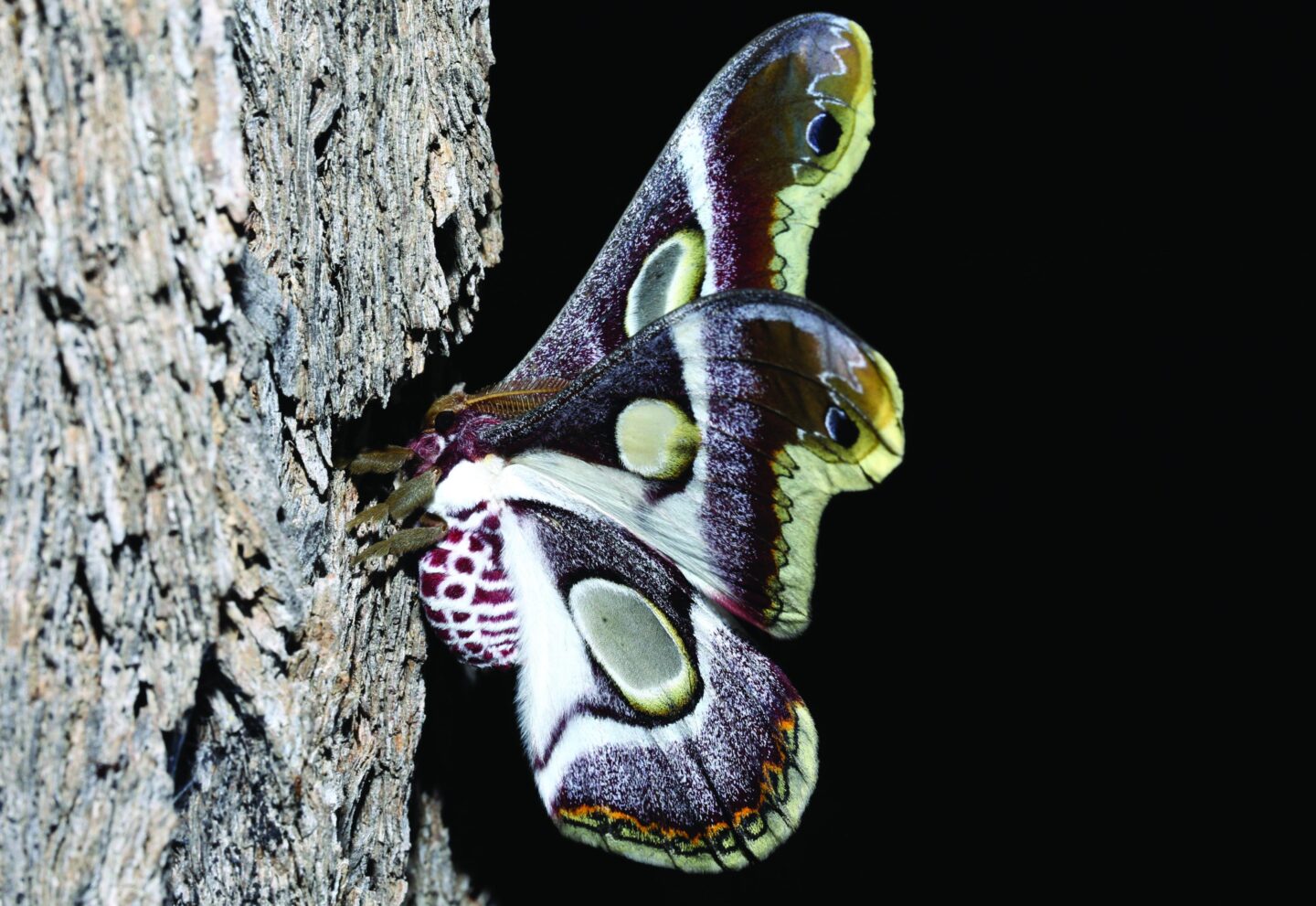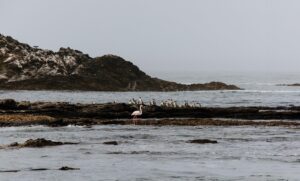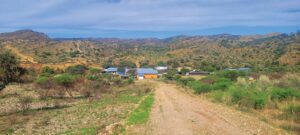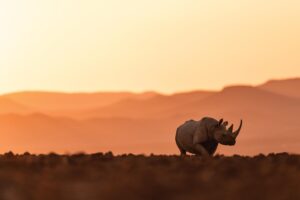

Looking for Namibia’s
EMPEROR MOTHS
some rare and life cycles unknown
They are nature’s flying nocturnal artworks, short-lived, some well-known but others secretive and little-known, often overseen and attracted to light. The adults do not feed at all, and the larvae – caterpillars – are very selective regarding their food plants. A few species are a valuable food source for humans, such as the so-called “mopane worms”, whereas of some species the caterpillars and food plants are not yet known.
Text Dirk Heinrich | Photographs Dirk Heinrich
From the Winter 2023 issue
Once the often beautifully coloured adults, with their characteristic large eyespots mainly on the hindwings, hatch, after having lain dormant as a pupa for months or sometimes even years, their very short life has only one aim: to find a partner, mate and, for the females, find a suitable foodplant on which to lay their eggs. It is only in these three to four days in their adult life when we can be fascinated by the beauty of these creatures.
A person who has been fascinated by these nocturnal butterflies since he was a young boy growing up in Lüderitzbucht, Tsumeb and Windhoek is Dr. Rolf Oberprieler, author of the book “The Emperor Moths of Namibia” published in 1995. He went to school in Tsumeb and Windhoek, studied and worked in Pretoria in South Africa and moved to Australia 25 years ago. Now retired, he visited Namibia together with his wife, Beate, born in Windhoek, in January and February 2023 to look for certain emperor moths and their caterpillars and foodplants, as well as to meet friends and relatives.
- Epiphora bauhiniae, the Southern African Atlas Moth, is arguably the most beautiful emperor moth in Namibia. It occurs in the north-central region from Windhoek and the Khomas Hochland north to the Otavi Mountains and from former Bushmanland to the Kavango region.
- The females of the Bryk’s Marbled Emperor lay their eggs on the foodplant in short rows, and each egg is attached to the leaf by a thin stalk.
- Freshly hatched larvae of the Bryk’s Marbled Emperor are a few millimetres long, black and bristly.
- In the fourth instar the larva of Bryk´s Marbled Emperor is already a colourful and spiky-looking caterpillar.
- A fully grown larva hanging from a leaf of its foodplant, as large caterpillars always do (they cannot stand on their fleshy legs, as often incorrectly portrayed in photographs). Soon the caterpillar will climb down from the bush and dig into the ground to pupate.
- The larva of the Bryk’s Marbled Emperor, is about 50 mm long and very well camouflaged as it feeds from the underside of the leaves of Elephant-root, its only known foodplant.
- The caterpillars of the Western Marbled Emperor have become a food source around Windhoek in some years and are in competition with mopane “worms” (the larvae of the emperor moth Gonimbrasia belina) in the north. Women collect the caterpillars in large quantities, empty the intestine and dry them. In good years, as in 2020, they are sold by the women for extra income.
- This species, the Western Marbled Emperor (Heniocha bioculata) are the most-seen and best-known emperor moth in the central areas of Namibia, where Black-thorn (Senegalia mellifera) occurs. The public often refers to this species as Hakkie Moth, because in some years they are abundant near and on hakkie trees. This species looks similar to Bryk’s Marbled Emperor but lacks the eyespots on the hindwings and has a different wing pattern.
- A freshly hatched Bryk’s Marbled Emperor male. Note the radar-like antennae, which he uses to find the female.
- The Yellow Marbled Emperor (Heniocha flavida) is similar to Bryk’s Marbled Emperor but has larger eyespots on the hindwings and a dark brown or black patch on the back of the thorax. It is also very similar to the Southern Marbled Emperor, Heniocha dyops, in South Africa.
- Ludia delegorguei, Delegorgue’s Playful Prince, is one of the smaller emperor moth species of the tribe Micragonini (princes), with a wingspan of 35-50 mm. The females are often found at lights during the night, but the males only very early in the mornings.
- The Speckled Emperor (Gynanisa macromaja) in Namibia is a different species from the one in South Africa (Gynanisa maja). Around Windhoek its caterpillars feed on the leaves of Camelthorn (Vachellia erioloba). The moths are extremely well camouflaged on tree trunks but flash their large eyespots when disturbed, seemingly to frighten off predators such as birds and lizards by imitating the eyes of an owl.
Bryk´s Marbled Emperor (Heniocha distincta), a Namibian endemic, was one of his target species as its life cycle remained unknown, even 64 years after it had been described. Near Windhoek he managed to find males and females and, for the first time ever, also eggs and caterpillars on Elephant-root (Elephantorrhiza suffruticosa). The caterpillars pupated a few days later, and a first moth hatched at the end of February – the proof that they are indeed Heniocha distincta! Some of the larvae reared from the eggs also recently pupated, so that he could record and photograph the entire life cycle.
The information is needed for a new book on the emperor moths of southern Africa, on which Oberprieler is currently working. He has now recorded 31 species of these moths (classified as the family Saturniidae) to occur in Namibia, more than a third of the number present in southern Africa.
Efforts to find the Spotted Prince (Ludia corticea), a small species described in 1922 by Karl Jordan from one male and four females collected near Windhoek and never reported since, were unfortunately unsuccessful due to rain and cold weather disrupting the collecting efforts.
I was surprised of the beauty of the Southern African Atlas Moth (Epiphora bauhiniae), which I had never seen before despite the fact that it occurs in and around Windhoek. I most probably have seen Bryk´s Marbled Emperor and also the similar Yellow Marbled Emperor (Heniocha flavida) before but did not recognise them, because they look similar to the common Western Marbled Emperor (Heniocha bioculata) but have four eyespots on the wings, two on the forewings and two on the hindwings (H. bioculata has only two, on the forewings). One has to take a close look at these jewels of the night to spot the differences between the different species.
The Namibian emperor moths habour yet more surprises. For example, according to Oberprieler the Speckled Emperor found here is a not the same species as the one in South Africa (Gynanisa maja), and it is therefore necessary to take a closer look at its caterpillars in all their developmental stages as well. TNN
Dr Rolf Oberprieler – For the first time at the end of January 2023, Dr. Rolf Oberprieler, author of the book “The Emperor Moths of Namibia”, found the eggs and caterpillars of the Bryk´s Marbled Emperor, a Namibian endemic, outside Windhoek on a farm in the Khomas Hochland. Here he is looking for the larvae on Elephant-root, the only known foodplant of the species.






